Themed collection ChemComm Milestones – First Independent Articles

Aggregation-induced emission luminogens for latent fingerprint detection
This highlight summarizes the advancements in aggregation-induced emission luminogens (AIEgens) for visualizing latent fingerprints.

Chem. Commun., 2024,60, 8314-8338
https://doi.org/10.1039/D4CC02026J
Metal–organic frameworks (MOFs) for hybrid water electrolysis: structure–property–performance correlation
Structure–property–performance correlation of MOFs for various AORs in hybrid water electrolysis.

Chem. Commun., 2024,60, 8020-8038
https://doi.org/10.1039/D4CC02729A
Unlocking novel therapies: cyclic peptide design for amyloidogenic targets through synergies of experiments, simulations, and machine learning
Proposed de novo peptide design strategy against amyloidogenic targets. After initial computational preparation of the binder and target, the computational and experimental validation are incorporated in iterative machine learning powered cycles to generate better and improved peptide-based targets.

Chem. Commun., 2024,60, 632-645
https://doi.org/10.1039/D3CC04630C
Frontiers in nonviral delivery of small molecule and genetic drugs, driven by polymer chemistry and machine learning for materials informatics
Materials informatics (MI) has immense potential to accelerate the pace of innovation and new product development for polymer-based therapeutic delivery platforms in biotechnology.
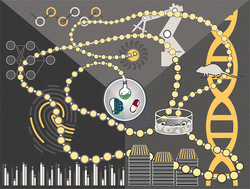
Chem. Commun., 2023,59, 14197-14209
https://doi.org/10.1039/D3CC04705A
Designing strong, fast, high-performance hydrogel actuators
This highlight summarizes the strategies to improve mechanical and actuation performance of hydrogel actuators, which could broaden their potential applications.
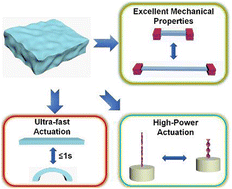
Chem. Commun., 2023,59, 7141-7150
https://doi.org/10.1039/D3CC01545A
Manufacturing polymeric porous capsules
The review paper outlines the current state-of-the-art strategies adopted to fabricate polymeric porous capsules which represent a novel supramolecular construct that broadens the applicability and versatility of self-assembled polymeric systems.
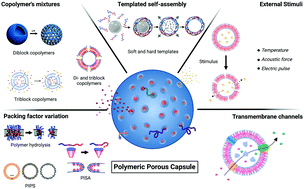
Chem. Commun., 2022,58, 4409-4419
https://doi.org/10.1039/D1CC06565C
Current electrochemical approaches to selective deuteration
A highlight of recent synthetic methods for selective deuteration of organic molecules using electrochemistry.
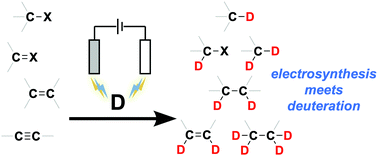
Chem. Commun., 2022,58, 2944-2953
https://doi.org/10.1039/D2CC00344A
Engineering poly(ethylene glycol) particles for targeted drug delivery
Poly(ethylene glycol) (PEG) particles can be prepared using templating and self-assembly methods and endowed with stealth and targeting properties for targeted drug delivery.
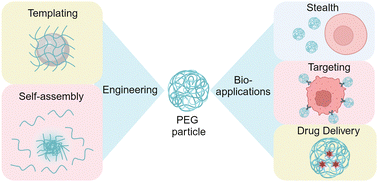
Chem. Commun., 2024,60, 2591-2604
https://doi.org/10.1039/D3CC06098E
Configuring solid-state batteries to power electric vehicles: a deliberation on technology, chemistry and energy
Solid-state batteries are configured by deliberation of technology and energy, with material chemistries and processing parameters necessary to target the requirements of the roadmap of future energy-dense and safe batteries.
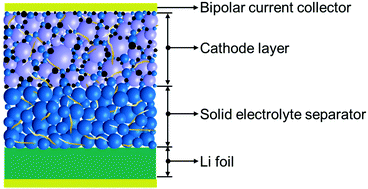
Chem. Commun., 2021,57, 12587-12594
https://doi.org/10.1039/D1CC04368D
Organelle-targeted photothermal agents for cancer therapy
This feature article summarizes the recent advances in organelle-targeted PTT agents over the past ten years.
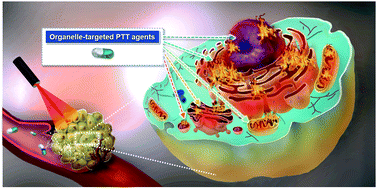
Chem. Commun., 2021,57, 7731-7742
https://doi.org/10.1039/D1CC02168K
Experimental determination of charge carrier dynamics in carbon nitride heterojunctions
We review the current understanding of charge carrier dynamics in carbon nitride heterojunctions and highlight open questions in the field.
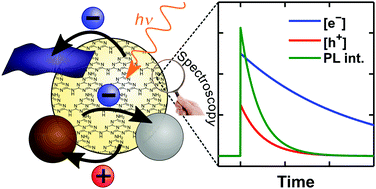
Chem. Commun., 2021,57, 1550-1567
https://doi.org/10.1039/D0CC06841A
A streamlined steric-shielding approach toward efficient narrowband (FWHM ∼ 18 nm) ultra-violet emitters for OLEDs
Herein, a simple, yet versatile molecular design was unraveled to develop a narrowband ultraviolet (UV) emitter by strategically integrating indolo[3,2,1-jk]carbazole and carbazole through a non-conjugative mode.

Chem. Commun., 2025,61, 18116-18119
https://doi.org/10.1039/D5CC04554A
Surface acidity as the decisive descriptor for hydroxyl-mediated hydrogen spillover in hydrogen isotope exchange
Support surface acidity is established as the decisive descriptor governing hydrogen spillover on non-reducible oxides.

Chem. Commun., 2025,61, 17906-17909
https://doi.org/10.1039/D5CC04894J
Precise heteroatom engineering for iodine capture promotion in porous organic cages
Through a precise heteroatom engineering strategy, the iodine capacities of POCs were improved. Among them, SePOC obtained an iodine capacity of up to 4.43 g g−1, and was fabricated as a thin film sensor for the first time to detect iodine vapor.

Chem. Commun., 2025, Advance Article
https://doi.org/10.1039/D5CC04036A
A diazadiphospholenium cation featuring a reactive P![[double bond, length half m-dash]](https://www.rsc.org/images/entities/char_e006.gif) P bond: synthesis and reversible main-group bond activation
P bond: synthesis and reversible main-group bond activation
A readily accessible diazadiphospholenium cation with a reactive P![[double bond, length half m-dash]](https://www.rsc.org/images/entities/char_e006.gif) P bond enables selective [4+2] cycloadditions and reversible E–E bond activation, highlighting its utility in main-group bond activation.
P bond enables selective [4+2] cycloadditions and reversible E–E bond activation, highlighting its utility in main-group bond activation.
![Graphical abstract: A diazadiphospholenium cation featuring a reactive P [[double bond, length half m-dash]] P bond: synthesis and reversible main-group bond activation](/en/Image/Get?imageInfo.ImageType=GA&imageInfo.ImageIdentifier.ManuscriptID=D5CC04820F&imageInfo.ImageIdentifier.Year=2025)
Chem. Commun., 2025,61, 17601-17604
https://doi.org/10.1039/D5CC04820F
Copper peroxide incorporated BSA-NPs: a pH-responsive, self-supplying source of reactive oxygen species for cancer cell destruction via polarization of macrophages to the M1 phenotype
Herein, we synthesized CuPer-BSA-NPs that release Cu2+ and H2O2 at acidic pH, activating a Fenton-type reaction to produce ˙OH radicals, which polarize RAW 264.7 macrophages to the M1 phenotype for enhanced anti-cancer effects against HeLa cells.

Chem. Commun., 2025,61, 5605-5608
https://doi.org/10.1039/D5CC00216H
Benzyl ether: a dynamic covalent motif for designing a trans-ether based covalent adaptable network (CAN)
This report introduces benzyl ether-based trans-ether exchange as a robust dynamic chemistry to design a covalent adaptable network (CAN).

Chem. Commun., 2025,61, 5621-5624
https://doi.org/10.1039/D5CC00788G
Brønsted acid-mediated thiazole synthesis from sulfoxonium ylides
A Brønsted acid-mediated insertion of thioureas/thioamides into sulfoxonium ylides to synthesise 40 thiazoles (34–95% yields) under mild, metal-free conditions is described.

Chem. Commun., 2024,60, 12401-12404
https://doi.org/10.1039/D4CC03905J
Secondary structure changes as the potential H2 sensing mechanism of group D [FeFe]-hydrogenases
The H2 sensing mechanism in [FeFe]-hydrogenases involves a structural rearrangement of the protein backbone most likely involved in signal transduction.
![Graphical abstract: Secondary structure changes as the potential H2 sensing mechanism of group D [FeFe]-hydrogenases](/en/Image/Get?imageInfo.ImageType=GA&imageInfo.ImageIdentifier.ManuscriptID=D4CC03098B&imageInfo.ImageIdentifier.Year=2024)
Chem. Commun., 2024,60, 10914-10917
https://doi.org/10.1039/D4CC03098B
Removal of mercury and lead ions from water using bioinspired N3Se3 type small sized moieties
Small sized N3Se3 moieties function as excellent Hg(II) and Pb(II) removal agents from water.

Chem. Commun., 2024,60, 9841-9844
https://doi.org/10.1039/D4CC03587A
A π-extended β-diketiminate ligand via a templated Scholl approach
We report a novel redox active β-diketiminate ligand embedded within a 24-electron π-system, prepared using a templated Scholl oxidation strategy.

Chem. Commun., 2024,60, 6663-6666
https://doi.org/10.1039/D4CC01627K
Chemoselective oxidation of aromatic aldehydes to carboxylic acids: potassium tert-butoxide as an anomalous source of oxygen
A chemoselective strategy for the oxidation of aromatic and heteroaromatic aldehydes to corresponding carboxylic acids has been developed wherein potassium tert-butoxide acts as a source of oxygen.

Chem. Commun., 2024,60, 6544-6547
https://doi.org/10.1039/D4CC01639D
Deoxyfluorinated amidation and esterification of carboxylic acid by pyridinesulfonyl fluoride
2-Pyridinesulfonyl fluoride mediated deoxyfluorination of carboxylic acid to acyl fluoride, allowing one-pot amidation and esterification under mild conditions.

Chem. Commun., 2024,60, 4789-4792
https://doi.org/10.1039/D4CC00877D
Metal-driven folding and assembly of a minimal β-sheet into a 3D-porous honeycomb framework
Metal-mediated supramolecular assembly of a minimal β-sheet peptide revealed a hetero terminal peptide assembled into a 3D porous honeycomb framework.

Chem. Commun., 2024,60, 2621-2624
https://doi.org/10.1039/D3CC05185D
Mixed anion control of negative thermal expansion in a niobium oxyfluoride
Substituting oxygen with fluorine tunes between positive and negative thermal expansion in niobium oxyfluoride.

Chem. Commun., 2024,60, 2548-2551
https://doi.org/10.1039/D3CC06129A
Insights into interfacial mechanisms: CsPbBr3 nanocrystals as sustainable photocatalysts for primary amine oxidation
This study highlights CsPbBr3 nanocrystals as a potent photocatalyst for oxidative coupling of primary amines to imines, where interfacial interactions markedly impact the reaction yield.
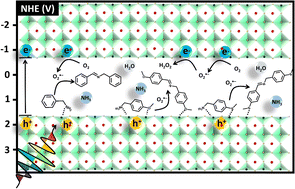
Chem. Commun., 2024,60, 2365-2368
https://doi.org/10.1039/D3CC05725A
Insights into non-covalent interactions in dicopper(II,II) complexes bearing a naphthyridine scaffold: anion-dictated electrochemistry
A naphthyridine-based bis(μ-hydroxido)dicopper(II,II) family of complexes exhibits anions influencing their electrochemical properties through non-covalent interactions.

Chem. Commun., 2024,60, 2228-2231
https://doi.org/10.1039/D3CC06264C
Synthesis of penta- and hexa(3,4-thienylene): size-dependent structural properties of cyclic oligothiophenes
Penta- and hexa(3,4-thienylene)s were synthesized and their nonplanar macrocyclic structures were determined by X-ray crystallography. NMR spectroscopy and theoretical calculation revealed size-dependent isomerization behavior.
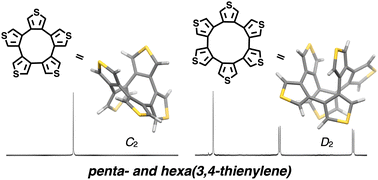
Chem. Commun., 2023,59, 11129-11132
https://doi.org/10.1039/D3CC03508E
Ru(II)/Ru(IV)-catalyzed C(sp2)–H allylation with alkene difunctionalization to access isochroman-1-imines
C(sp2)–H allylation and alkene difunctionalization were combined to access isochroman-1-imines. Experimental results and DFT analysis indicated that C–H allylation occurred via a Ru(IV)-allyl transfer (redox) mechanism instead of an olefin insertion.

Chem. Commun., 2023,59, 9497-9500
https://doi.org/10.1039/D3CC01604H
Catalytic dehydrative amide bond formation using aqueous ammonia: synthesis of primary amides utilizing diboronic acid anhydride catalysis
We have developed a first catalytic methodology for the synthesis of primary amides by the catalytic dehydrative amidation of α- or β-hydroxycarboxylic acids using inexpensive and safe aqueous ammonia.

Chem. Commun., 2023,59, 7391-7394
https://doi.org/10.1039/D3CC02071A
Olefin hydroboration catalyzed by an iron-borane complex
Metal–Ligand cooperativity using a well-defined iron(0)complex catalyzes olefin hydroboration.

Chem. Commun., 2023,59, 7427-7430
https://doi.org/10.1039/D3CC00494E
Bionic electroluminescent perovskite light-emitting device
The FC-PeLED system simulates the natural process of bionics of plant colors from green to brown through a low energy input.

Chem. Commun., 2023,59, 7196-7199
https://doi.org/10.1039/D3CC01533E
Electrochemical C–F bond activation of trifluoromethylarenes using silylium ions
We report a mild, electrochemical trihydrodefluorination (e-THDF) for breaking highly stable C–F bonds in trifluoromethyl arenes to form the corresponding methyl arene products.
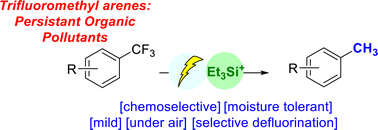
Chem. Commun., 2023,59, 6694-6697
https://doi.org/10.1039/D3CC01850D
VITAS, a sensitive in vivo selection assay to discover enzymes producing antiviral natural products
We demonstrate the VITAS (Viral polymerase-Inhibition Toxin-Associated Selection) assay for the in vivo selection and discovery of enzymes producing one of the largest groups of antivirals, namely antiviral nucleotide analogues (ANAs).
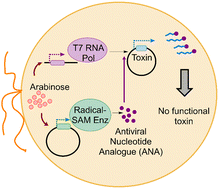
Chem. Commun., 2023,59, 5419-5422
https://doi.org/10.1039/D3CC00638G
All-alike hollow nanotubes of g-C3N4 converting photons into fuel by splitting water
Oxygen-containing porous CN hollow nanotubes were engineered by facile thermal polycondensation of oxalic acid-assisted supramolecular aggregates and revealed superior photocatalytic hydrogen production.

Chem. Commun., 2023,59, 5399-5402
https://doi.org/10.1039/D3CC01028G
Convergent synthesis of triarylamines via Ni-catalyzed dual C(sp2)–H amination from benzamides with benzohydroxamic acids
A nickel-catalyzed dual C(sp2)–H amination of N-quinolylbenzamides using broad-spectrum hydroxylamine as the amino source is developed for the selective synthesis of triarylamines in a single-step manner.

Chem. Commun., 2023,59, 4360-4363
https://doi.org/10.1039/D3CC00165B
Highly diastereo- and enantioselective C2 addition of 5H-oxazol-4-ones to γ-keto-α,β-unsaturated esters
The novel direct C2-addition of azlactones to γ-keto-α,β-unsaturated esters was achieved with excellent stereoselectivities, and revealed an unusual π–π interaction effect between the substrate and catalyst.

Chem. Commun., 2023,59, 3606-3609
https://doi.org/10.1039/D3CC00554B
Axial optimization of biomimetic nanoenzyme catalysts applied to oxygen reduction reactions
A typical synthesis of the FeN4X-SAzyme (x = F, Cl, Br, I) is based on high-temperature pyrolysis. The results showed that the chlorine-coordinated monatomic iron material (FeN4Cl-SAzyme) was a promising catalyst for the oxygen reduction reaction.

Chem. Commun., 2023,59, 3550-3553
https://doi.org/10.1039/D2CC06197J
Gas-phase organometallic catalysis in MFM-300(Sc) provided by switchable dynamic metal sites
MFM-300(Sc) was explored as a catalyst for the gas-phase hydrogenation of acetone. The reaction was driven by Sc(III) dynamics sites.
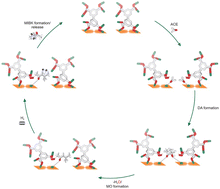
Chem. Commun., 2023,59, 3273-3276
https://doi.org/10.1039/D2CC06935K
Rapid access to C2-quaternary 3-methyleneindolines via base-mediated post-Ugi Conia-ene cyclization
Highly efficient synthesis of diverse 2,2-disubstituted 3-methyleneindoline derivatives through a one-pot base-promoted post-Ugi 5-exo-dig “Conia-ene”-type cyclization has been disclosed.

Chem. Commun., 2023,59, 3099-3102
https://doi.org/10.1039/D2CC06281J
V-shaped donor–acceptor organic emitters. A new approach towards efficient TADF OLED devices
We report the synthesis and characterization of a series of donor–acceptor TADF emitters with a new architecture, where the donor moiety and the dibenzazepine-based acceptor moiety are separated by a phenylene linker in a V-shaped spatial arrangement.
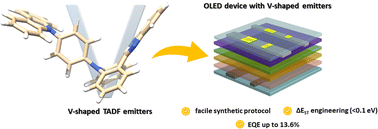
Chem. Commun., 2023,59, 2815-2818
https://doi.org/10.1039/D2CC06978D
Facile separation of cyclic aliphatic and aromatic vapors using crystalline thiacalixarene assemblies with preorganized channels
Crystalline thiacalix[4]arene assemblies adsorb cyclic aliphatic vapors preferentially over aromatic vapors. High-purity aliphatics can be easily obtained from aliphatic/aromatic mixtures by exposing the crystals to air after vapor adsorption.
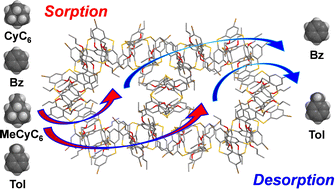
Chem. Commun., 2023,59, 2604-2607
https://doi.org/10.1039/D2CC05647J
Salicylaldehydate coordinated two-dimensional-conjugated metal–organic frameworks
We have demonstrated a facile, scalable, and green synthetic route to produce a novel class of semiconductive 2D-c-MOFs (SA-MOFs). This novel MOF chemistry opens rich opportunities for the exploration of functionally diverse open frameworks.
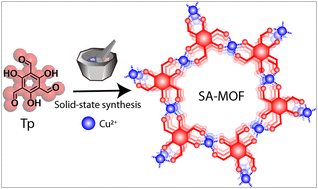
Chem. Commun., 2023,59, 2608-2611
https://doi.org/10.1039/D2CC06283F
Direct electrochemical identification of rare microscopic catalytic active sites
Local voltammetric analysis (combined with a new data processing protocol) in a scanning electrochemical droplet cell format is used to directly identify previously unseen regions of elevated electrocatalytic activity on the basal plane of 2H-MoS2.
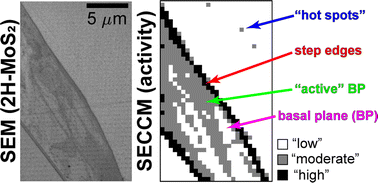
Chem. Commun., 2023,59, 2287-2290
https://doi.org/10.1039/D2CC06316F
Deep learning-assisted analysis of single molecule dynamics from liquid-phase electron microscopy
Deep learning methods, U-Net, UNet++, were applied to the analysis of single molecule movies obtained from liquid-phase electron microscopy.
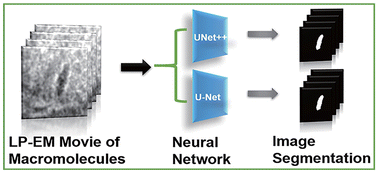
Chem. Commun., 2023,59, 1701-1704
https://doi.org/10.1039/D2CC05354C
Adsorbate-dependent phase switching in the square lattice topology coordination network [Ni(4,4′-bipyridine)2(NCS)2]n
The square lattice coordination network sql-1-Ni-NCS exhibits adsorbate-dependent switching pressures and sorption uptakes.
![Graphical abstract: Adsorbate-dependent phase switching in the square lattice topology coordination network [Ni(4,4′-bipyridine)2(NCS)2]n](/en/Image/Get?imageInfo.ImageType=GA&imageInfo.ImageIdentifier.ManuscriptID=D2CC06549E&imageInfo.ImageIdentifier.Year=2023)
Chem. Commun., 2023,59, 559-562
https://doi.org/10.1039/D2CC06549E
Top-down manufacturing of efficient CO2 reduction catalysts from the gasification residue carbon
A “top-down” strategy has been demonstrated to transform gasification residue carbon into a Ni–N–C single atom catalyst at gram scale.

Chem. Commun., 2023,59, 611-614
https://doi.org/10.1039/D2CC05081A
Catch-enrich-release approach for amine-containing natural products
Chemoselective approach to extract amine-containing natural products from complex matrices. The enzymatic release from the probe affords the underivatised compounds as products.
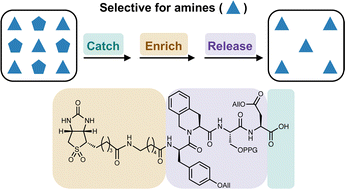
Chem. Commun., 2022,58, 12560-12563
https://doi.org/10.1039/D2CC04905H
Engineered myoglobin as a catalyst for atom transfer radical cyclisation
Myoglobin was subjected to site-directed mutagenesis and transformed into a catalyst able to perform the atom transfer radical reaction.

Chem. Commun., 2022,58, 10989-10992
https://doi.org/10.1039/D2CC03227A
A fluorescent probe strategy for the detection and discrimination of hydrogen peroxide and peroxynitrite in cells
We report a fluorescent probe strategy that provides the potential to detect and discriminate hydrogen peroxide and peroxynitrite in cells.
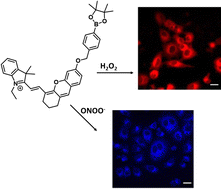
Chem. Commun., 2022,58, 10699-10702
https://doi.org/10.1039/D2CC03406A
Design of high-avidity multivalent ligand structures that target cells with high ligand economy
Novel cell-targeting ligand structures are constructed with a spikey core scaffold, where multiple copies of coiled-coil peptide nanorods are conjugated on the surface of a peptide nanosheet.
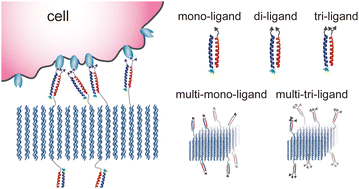
Chem. Commun., 2022,58, 9802-9805
https://doi.org/10.1039/D2CC03296A
tert-Butyl nitrite triggered radical cascade reaction for synthesizing isoxazoles by a one-pot multicomponent strategy
TBN/Na2S2O8-mediated radical cascade reaction of alkenes with aldehydes involving the formation of diverse new bonds in one-pot.
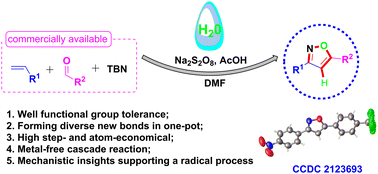
Chem. Commun., 2022,58, 9152-9155
https://doi.org/10.1039/D2CC02823A
Identification of a pyrone-type species as the active site for the oxygen reduction reaction
A bicyclic pyrone-type species on carbon catalysts was identified as the active site for the oxygen reduction reaction.
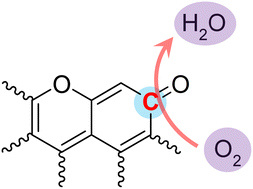
Chem. Commun., 2022,58, 8998-9001
https://doi.org/10.1039/D2CC03093D
Thermal properties of single-layer MoS2–WS2 alloys enabled by machine-learned interatomic potentials
Machine-learned interatomic potential for the estimation of thermal transport properties of MoxW1−xS2 systems.

Chem. Commun., 2022,58, 6902-6905
https://doi.org/10.1039/D2CC02519A
A Ni(COD)2-free approach for the synthesis of high surface area porous aromatic frameworks
A new method for the synthesis of high surface area porous aromatic frameworks that does not use Ni(COD)2 is described.
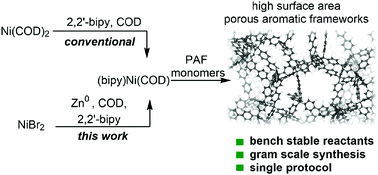
Chem. Commun., 2022,58, 6841-6844
https://doi.org/10.1039/D2CC01720B
Hard–soft chemistry guides the adaptable charge transport in lysine-doped heptapeptide junctions
This work for the first time introduces hard–soft acid base theory to analyze the counterion-modulated peptide charge transport and rationalizes the enhancement of peptide charge transport by the peptide-counterion interactions.
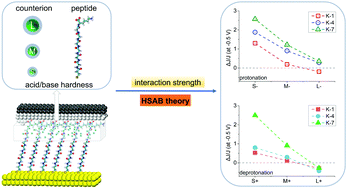
Chem. Commun., 2022,58, 6405-6408
https://doi.org/10.1039/D2CC00752E
Fluorene analogues of xanthenes – low molecular weight near-infrared dyes
Lighter analogues of xanthene dyes show near-infrared absorption and emission, strongly redshifted due to the antiaromatic character of the fluorene scaffold.
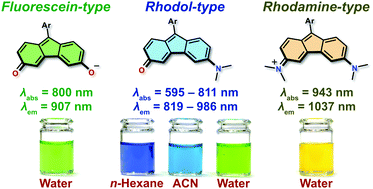
Chem. Commun., 2022,58, 5455-5458
https://doi.org/10.1039/D2CC00561A
Crystalline radical cations of bis-BN-based analogues of Thiele's hydrocarbon
Radical cations of air-stable bis-BN-based analogues of Thiele's hydrocarbon have been isolated.

Chem. Commun., 2022,58, 5391-5394
https://doi.org/10.1039/D2CC01254E
Effect of Na+ and K+ on the cucurbituril-mediated hydrolysis of a phenyl acetate
Cucurbit[7]uril accelerates acid hydrolysis and screens the reaction centre from the neighbouring group. The coordination of alkali metal cations to the macrocycle portal uncompetitively reduces the catalytic activity.

Chem. Commun., 2022,58, 5249-5252
https://doi.org/10.1039/D2CC00772J
Synthesis of spiropyrans via the Rh(III)-catalyzed annulation of 3-aryl-2H-benzo[b][1,4]oxazines with diazo ketoesters
An efficient Rh(III)-catalyzed 1 : 2 coupling of 3-aryl-2H-benzo[b][1,4]oxazines with diazo ketoesters has been realized via twofold C–H activation followed by unusual [3+3] and [4+2] annulation, providing a straightforward strategy to access polycyclic spiropyrans.
![Graphical abstract: Synthesis of spiropyrans via the Rh(iii)-catalyzed annulation of 3-aryl-2H-benzo[b][1,4]oxazines with diazo ketoesters](/en/Image/Get?imageInfo.ImageType=GA&imageInfo.ImageIdentifier.ManuscriptID=D2CC00916A&imageInfo.ImageIdentifier.Year=2022)
Chem. Commun., 2022,58, 5144-5147
https://doi.org/10.1039/D2CC00916A
Dark-induced vertical growth of chemobrionic architectures in silver-based precipitating chemical gardens
The light sensitivity of many silver compounds has restricted the observation of silver-based chemical gardens.
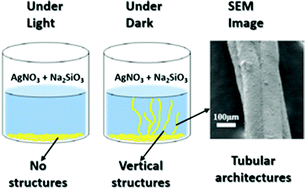
Chem. Commun., 2022,58, 4172-4175
https://doi.org/10.1039/D1CC06430D
Melamine-induced synthesis of a structurally perfect kagomé antiferromagnet
A structurally perfect kagomé antiferromagnet {[Cu3(bpy)6](SiF6)3(melamine)8(H2O)4}n was synthesized by introducing C3 symmetrical melamine molecules.
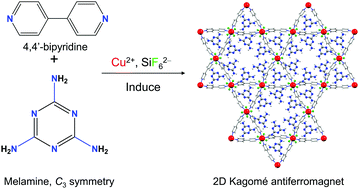
Chem. Commun., 2022,58, 3763-3766
https://doi.org/10.1039/D2CC00416J
Two-dimensional Zr/Hf-hydroxamate metal–organic frameworks
Novel two-dimensional Zr/Hf-hydroxamate MOFs, featuring chelated mononuclear nodes, were synthesized and exhibited great chemical stability and morphological tunability.
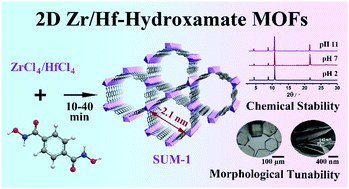
Chem. Commun., 2022,58, 3601-3604
https://doi.org/10.1039/D2CC00213B
Potassium tert-butoxide promoted regioselective deuteration of pyridines
Regioselective β- and γ-deuteration of pyridine was achieved under mild condition through a carbanion pathway with dimsyl-d5 intermediate.

Chem. Commun., 2022,58, 3497-3500
https://doi.org/10.1039/D1CC07128A
CuCoFe Layered double hydroxides as laccase mimicking nanozymes for colorimetric detection of pheochromocytoma biomarkers
A convenient, sensitive and reliable laccase-mimicking CuCoFe-LDHzyme was fabricated for the smartphone-based colorimetric detection of pheochromocytoma biomarkers.
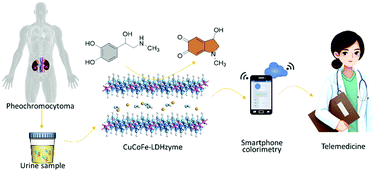
Chem. Commun., 2022,58, 1982-1985
https://doi.org/10.1039/D1CC06612A
Vapor-triggered reversible crystal transformation of a nickel-based magnetic molecular switch
Vapor-triggered crystal-to-crystal transformation between a discrete trinuclear complex [Ni3(sih)2(py)8] and a two-dimensional (2D) coordination polymer [Ni3(sih)2(py)2]n·2DMF·2H2O was demonstrated, showing a solid-state coordination-induced spin state switch behavior.

Chem. Commun., 2022,58, 1954-1957
https://doi.org/10.1039/D1CC06076G
In situ observation of heterogeneous catalytic organic reactions via aggregation-induced emission luminogens
A customized aggregation-induced emission luminogen allows the direct visualization of catalytic retro-Diels–Alder reaction and catalyst screening.

Chem. Commun., 2022,58, 1601-1604
https://doi.org/10.1039/D1CC06706K
Fully soft organic electrochemical transistor enabling direct skin-mountable electrophysiological signal amplification
Fully soft organic electrochemical transistors and a skin-mountable electrophysiological signal amplifier were developed by all soft components based on, particularly stretchable PEDOT:PSS enabled by crosslinking between PEG and DVS.
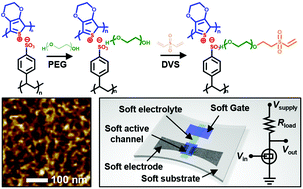
Chem. Commun., 2022,58, 1298-1301
https://doi.org/10.1039/D1CC04884H
Coordination effect enabled palladium-catalyzed regioselective O-alkylation of 2-pyridones
A novel tactic for the regioselective O-alkylation of 2-pyridones has been realized through palladium catalysis facilitated by silver carbonate in moderate to high yields, the coordination effect between palladium and nitrogen on the pyridine ring plays a versatile role.
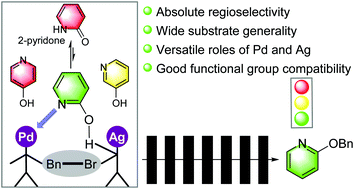
Chem. Commun., 2022,58, 1215-1218
https://doi.org/10.1039/D1CC06110K
Reconstruction of bimetal CoFe0.13-MOF to enhance the catalytic performance in the oxygen evolution reaction
A new solvothermal reconstruction method recovers the original morphology of the catalyst and the product presents extraordinary stability.

Chem. Commun., 2022,58, 1115-1118
https://doi.org/10.1039/D1CC06314F
About this collection
In this new feature we are celebrating authors' first articles as independent researchers. ChemComm is here to support researchers throughout their careers. Whether you’re a first-time author or a senior academic, you can trust us to handle your submission fairly and efficiently. This momentous milestone marks the beginning of an independent academic career and we are proud to champion authors through this stage and beyond.
Read our feature interviews with the authors on our blog.